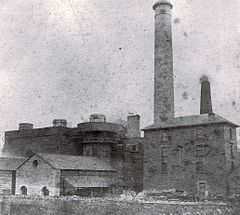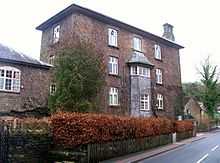Parkend Ironworks
| Parkend Ironworks | |
|---|---|
 <div style=""font-size:small;";"> c1880. Awaiting Demolition; the three furnaces can be seen on the left. The building to the right is the engine house which has survived. | |
 Parkend Ironworks | |
| SO6168007887 | |
| List of places: UK • England • Gloucestershire | |
Parkend Ironworks, also known as Parkend Furnace, in the village of Parkend, in the Forest of Dean, Gloucestershire, England, was a coke-fired furnace built in 1799. Most of the works were demolished between 1890 and 1908, but the engine house survived and is arguably the best preserved example of its kind to be found in the United Kingdom.
Background
During the 17th century Parkend had been, at different times, the location of two charcoal-fired Crown furnaces, known as the King's Ironworks; In 1612 James I contracted the Earl of Pembroke to build and run a blast furnace and forge at ‘Parke End’, bringing with it the first real settlement at what was to become the village of Parkend.[1] The furnace was destroyed on the orders of Parliament, during the Civil War, in 1644. After the war, in 1653, Parliament instructed that another furnace should be built, a short distance downstream from the first. Being located in a royal forest, control of the furnace returned to the Crown after the restoration of the monarchy in 1660. It ceased production, and was demolished, in 1674.[2]
Iron was first successfully smelted with coke in 1709 at Coalbrookdale, in Shropshire. Despite there being extensive coal measures in the Forest of Dean, local coal did not produce coke that was ideal for smelting and Forest ironmasters were reluctant to invest in the new technology. It was not until the last decade of the 18th century that coke-fired furnaces began to make an appearance, with Parkend, and its many coalmines, once again considered an ideal location for iron production. It was one of three coke-fired ironworks, Cinderford and Whitecliff being the others, that were built almost simultaneously in the Forest.[3]
History
In 1799 work commenced on Parkend Ironworks. It was the third coke-fired ironworks to be built in the Forest of Dean, but was beset by technical problems and ceased production around 1807. Around 1820, Moses Teague, working at Darkhill Ironworks, discovered a way to make good iron from local coke. To exploit his discovery he formed the 'Forest of Dean Iron Co', and re-opened Parkend Ironworks in 1824.[1]

By 1835 the site had grown to include workers’ cottages, casting houses, blacksmith’s and carpenter’s sheds, a counting house, offices, a beerhouse, and many other ancillary buildings. In 1849 a second steam engine was added.

Business was booming and in 1871 a third furnace was also added; a ‘hot blast’ design which was the very latest technology at that time. Just four years later, however, the iron trade went into recession and the ironworks closed in 1877.[5]
Most of the works were demolished between 1890 and 1908, but the engine house and some ancillary buildings survived to became the country’s first Forester Training School in 1910. During the Second World War, it was used by the American army as a barracks. In 1971 it was sold to Avon County Council and became the Dean Field Studies centre.[6] In 1984 it was afforded Grade II Listed Building protection.[7] The building is not open to the public, but can be viewed from the roadside.
See also
References
- ↑ 1.0 1.1 British History Online
- ↑ Anstis, p. 15
- ↑ The Whitecliff Ironworks in the Forest of Dean, Part one, page 19
- ↑ Anstis, p. 31
- ↑ Anstis, pp. 34–35
- ↑ Anstis, p. 35
- ↑ British Listed Buildings
Further reading
- Anstis, Ralph. The Story of Parkend. ISBN 978-1-899889-04-4.